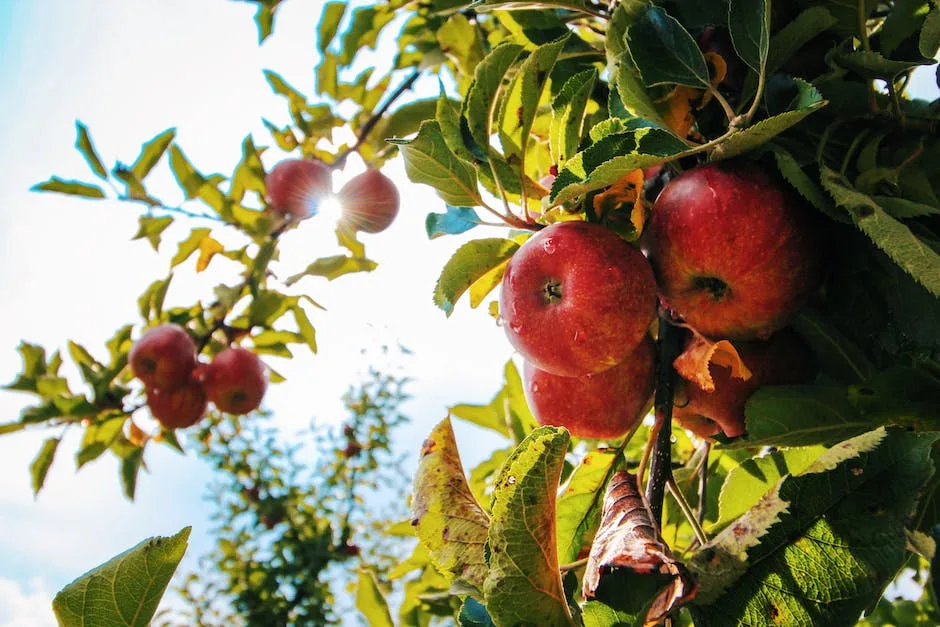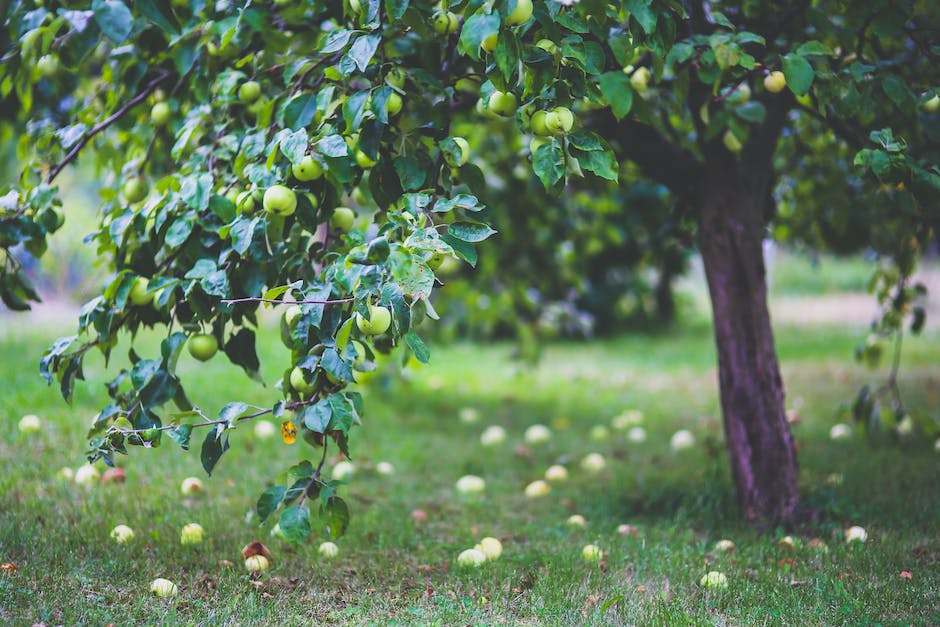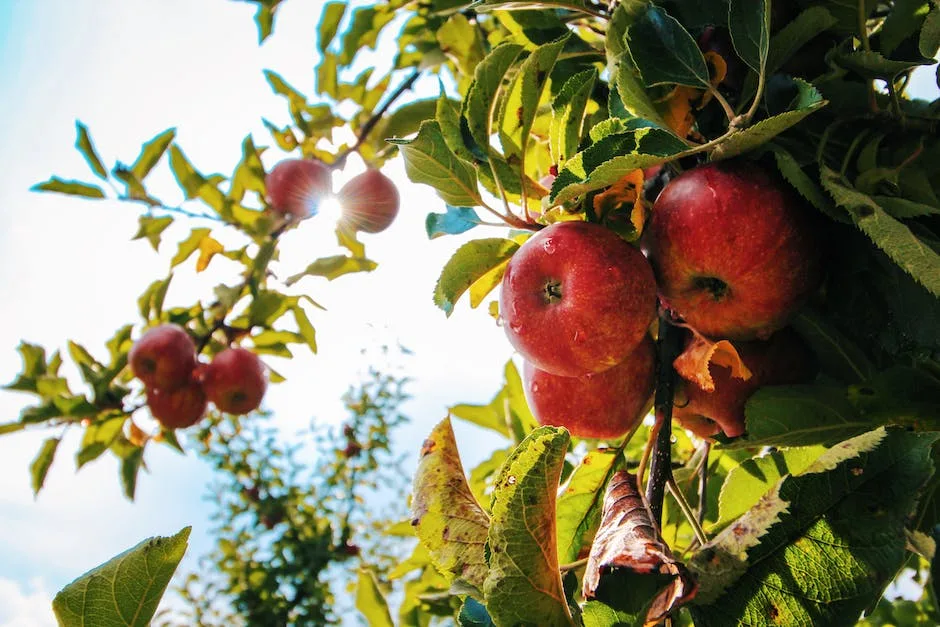There are many reasons why apple tree leaves may turn yellow. One possibility is that the tree is not receiving enough water. Too much or too little water can both cause leaves to turn yellow. Another possible reason is that the tree is not getting enough nutrients. If the leaves are turning yellow in the middle or at the tips, it could be a sign of nutrient deficiency. Improper pruning can also cause leaves to turn yellow. If you suspect any of these reasons, try adjusting the tree’s care accordingly.
The most common reason for apple tree leaves to turn yellow is due to a lack of nitrogen in the soil. Nitrogen is an essential nutrient for plant growth and is typically taken up by plants through the roots. If the roots are unable to uptake enough nitrogen from the soil, the leaves will begin to turn yellow as the plant tries to “steal” nitrogen from the leaves to continue growing. Other reasons for yellowing leaves can include herbicide damage, drought stress, or nutrient imbalances.
How do I treat yellow leaves on my apple tree?
If you notice that the leaves on your tree are yellowing, it could be a sign of a pH problem or iron deficiency. To alleviate this problem, apply a fertilizer that contains chelated iron to the tree. You can also apply sulfur to the soil outside the dripline of the tree.
When a tree’s leaves start to yellow and drop, it’s usually a sign that the tree is not getting enough water. If the soil around the tree is bare, watering the tree every other day during the heat should help.
Can yellow tree leaves turn green again
When a leaf loses its chlorophyll, the plant begins to absorb leftover nutrients from the leaf. Once the leaf turns yellow, it is generally not possible to make it turn back green again. In cases of nutrient deficiencies, however, yellow leaf color may be able to green back up again with treatment.
If you see yellow leaves on your plant, it could be a sign that it is overwatered. If the leaves are fading to green or are bright yellow, this is a sure sign that your plant is getting too much water. The solution is to repot the plant in order to remove the soaked soil, and to water it less frequently. Alternatively, you could let the soil dry out and water the plant less often.
What does an overwatered apple tree look like?
If you see any of the following signs, your plant is likely being overwatered:
-New growth withering before it’s fully grown
-Slightly yellow or green leaves
-Fragile leaves that break easily
If you have some fruit trees, a boost in magnesium will do them a world of good. Epsom Salt is used on fruit trees or vegetables to help them yield larger, sweeter, and more fruits. It works great also for nut trees and fruit shrubs.
What is lacking when leaves turn yellow?
Chlorosis is a condition that results in the yellowing of leaves due to a lack of chlorophyll. Chlorophyll is a green pigment that trees synthesize from sunlight’s energy and the water and nutrients taken up by a tree’s root system. This pigment is what gives tree leaves their green color. When a tree is suffering from chlorosis, its leaves will begin to turn yellow and may eventually turn brown and fall off. This can be a serious problem for the tree, as it can impact the tree’s ability to produce food through photosynthesis. Chlorosis can be caused by a variety of factors, including nutrient deficiencies, diseases, and pests.
If you notice that your plant’s leaves are turning yellow, it may be due to a nitrogen deficiency. This can happen if the plant isn’t getting enough nitrogen in its soil. A potassium deficiency can also cause leaves to turn yellow, but you’ll notice that the edges of the leaves are turning yellow first. If you see these symptoms, you should take steps to correct the problem so that your plant can stay healthy.
What nutrient deficiency causes yellow leaves
Sulphur plays an important role in the formation of chlorophyll, and deficiencies can lead to yellow leaves and stunted growth.
It’s important to get rid of yellow or brown leaves not just for the sake of appearances, but also to help keep your plant healthy. Yellow or brown leaves are often a sign that a plant is struggling, and is more likely to be attacked by pests. Trimming or plucking away these leaves can help prevent any unwelcome critters from settling onto your plant.
How do you treat yellow leaves?
If your plants are starting to yellow, it may be because they are lacking nitrogen. Lower leaves are usually the first to start yellowing when a plant doesn’t have enough of this element. Over time, your plants can use up all the nitrogen that your potting mix may come with, so repotting with fresh soil can help with this problem. Or, you can supplement with a fertilizer that is high in nitrogen.
If you notice that your plant’s leaves are starting to turn yellow, it is likely that you are overwatering it. However, if you notice that the lower leaves are turning yellow and curling, it is likely that you are underwatering your plant. To determine which it is, check the soil for moisture.
Do yellow leaves mean a plant is overwatered
If you see yellow leaves on your plant, it could be a sign of either overwatering or underwatering. If the leaves are limp, it is more likely overwatering. If the leaves are crispy or curling, it is more likely underwatering.
If your plant is getting too much sun and the leaves are turning yellow, you may need to move it to a spot that gets less sun. You can also try to protect the plant from the sun bySheetssung making a makeshift Shade with a tarp or piece of cloth.
What does a tree with too much water look like?
A tree that is getting too much water will show signs of wilting or yellowing leaves, moss and fungus growth, and waterlogged blisters on the stems and leaves. If you see any of these signs, then it’s time to cut back on watering and let the tree dry out a bit.
Apple trees typically do not need to be watered every day. However, if you live in an area with little rainfall or your soil is particularly dry, you may need to water your apple trees more frequently to prevent them from becoming drought-stressed. Check the soil around your apple trees every few days and water them as needed to keep the soil moist but not soggy.
How do I know if my apple tree is getting enough water
If you notice any wilting, curling, or turning brown leaves on your trees, chances are your tree is in need of additional water.
The brown spots on the ends of the fruit are the first sign of infection. These spots will grow into concentric circles and rot the fruit. The tree’s leaves may develop small holes or purplish brown spots that look like a frog’s eyes.
Do coffee grounds help apple trees
Coffee grounds are a great addition to any fruit tree’s soil. They contain nitrogen, phosphorus, magnesium, and copper, all of which are essential to the tree’s health. Adding coffee grounds to the soil will also help raise the pH level, which is good for the tree.
It’s important to use the right fertilizer for your fruit trees. Miracle-Gro Water Soluble All Purpose Plant Food is not specifically labeled for fruit trees. For best results, use a fertilizer that is meant for fruit trees, such as Ferti-Lome Fruit, Citrus and Pecan Tree Food 19-10-5.
What is the best fertilizer for apple trees
Fruit trees prefer an organic, high nitrogen fertilizer, such as blood meal, soybean meal, composted chicken manure, cottonseed meal, or feather meal. Nitrogen is essential for fruit trees to produce healthy, vigorous growth.
One way to help prevent your plant from losing its chlorophyll is by using fertilizers to deliver the necessary nutrients. If your plant’s leaves are turning yellow, one of the main reasons is probably a nutrient deficiency. The most common nutrients for this issue are nitrogen, magnesium, iron, and calcium.
Does lack of nitrogen cause yellow leaves
Nitrogen is one of the essential nutrients for plant growth, and a deficiency can cause serious problems. Plants affected by nitrogen deficiency tend to be pale yellow-green in color and have slow or stunted growth. Yellowing from lack of nitrogen starts at the older leaves and moves on to newer leaves as the deficiency continues, with yellowing patterns varying by crop. Nitrogen deficiency can be remedied by applying a fertilizer high in nitrogen, but it is important to understand the symptoms and causes in order to properly address the problem.
People often use too much fertilizer in an effort to make their plants grow faster. However, the excess salt in the soil from too much fertilizer can actually “burn” the leaves, causing them to turn yellow. In the case of houseplants, changing the soil or leaching it with large amounts of water can correct the balance.
Final Words
There are many potential causes for apple tree leaves to turn yellow. Some common causes include nutrient deficiency, pest infestation, and disease. Nutrient deficiency is often caused by poor soil quality or improper fertilizer application. Pest infestation can cause leaves to turn yellow due to the pests feeding on the leaves or the plants stress from the infestation. Disease is another common cause of yellowing leaves and can be caused by bacteria, fungi, or viruses.
There are several possible causes for apple tree leaves to turn yellow, including nutrient deficiencies, pests, or diseases. In most cases, yellowing leaves can be addressed with some basic maintenance and care. However, if the problem persists, it is best to consult with a professional to diagnose the issue and determine the best course of action.
I’ve always been drawn to trees.
As a kid, I spent most of my free time outside, climbing, exploring, and trying to figure out the names of the trees around me.
That early curiosity eventually led me to study arboriculture and horticulture at Michigan State.
Later, I completed a degree in forestry at the University of Michigan.
I’ve been working in tree care and education ever since.
These days, I enjoy helping people learn more about the trees in their own backyards.
How they grow, how to care for them, and why they matter.
You don’t need to be an expert to appreciate trees.
A little curiosity goes a long way.
